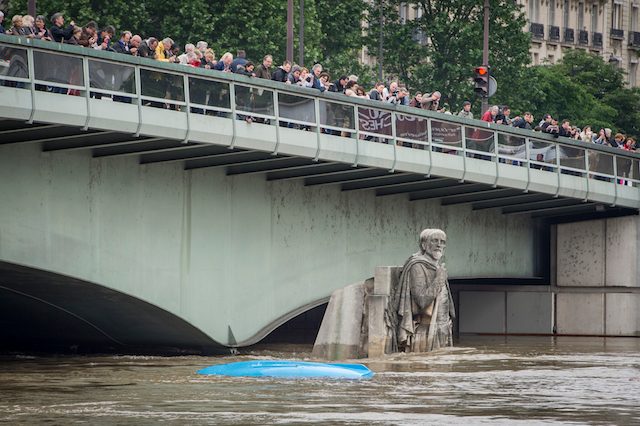SUMMARY
This is AI generated summarization, which may have errors. For context, always refer to the full article.

PARIS, France (3rd UPDATE) – The rain-swollen River Seine in Paris began to recede on Saturday, June 4, after reaching its highest level in three decades, easing fears after floods sent the Louvre and other riverside museums scrambling to protect their treasures.
From a peak of 6.10 meters (20 feet) in the early hours of Saturday, the river began to subside, falling to 5.99 meters at 5pm (1500 GMT), the environment ministry’s Vigicrues flood watch website said.
The record for the Seine is 8.62 meters, reached in 1910.
“We’re now in the stabilisation phase,”said Bruno Janet, Vigicrues’ head of modelling.
Across Europe, 18 people have been killed in floods that trapped people in their homes, felled trees and power lines, cut off roads and rail lines and and forced rescuers to navigate swamped streets in lifeboats.
Eleven died in the Germany states of Bavaria and Baden-Wuerttemberg, four in France, two in Romania and one in Belgium, according to an AFP compilation of official tolls and news stories.
As the Seine’s levels gradually lowered, the threat in France appeared to have shifted to the northeast, where feared storms could cause other rivers to burst their banks, and to the northern port of Le Havre where the Seine flows into the sea.
The Louvre and Orsay museums, which sit on opposite banks of the Seine, remained closed Saturday, a day after shutting their doors in a race to move art treasures out of basements to higher ground as a precautionary measure.
Paris firefighters warned people to keep away from dangerous parts of the river, but crowds gathered undeterred on bridges to snap pictures of the dramatic sight.
Pieces of driftwood, plastic bags and other detritus swept past in the muddy waters which engulfed the city’s famous riverside walkways, a popular haunt of strolling couples.
“It is a reminder that nature is more powerful than man and we cannot do anything, only wait,” said Gabriel Riboulet, a 26-year-old businessman, as he took in the scene.
Two metro stations remained closed and services on a train line that hugs the Seine was still suspended in places. Boat traffic was also suspended.
The City of Paris said it had opened two gyms to shelter the homeless.
More than 20,000 people have been evacuated over the past week from the Loire Valley and the greater Paris area.
The health ministry added on Saturday that nearly 500 patients from a dozen hospitals and 800 care home residents had also been moved.
Over 17,110 homes remained without power Saturday, electricity supplier Enedis said.
Hefty bill
Nationwide losses could reach more than 600 million euros ($680 million), said Bernard Spitz of France’s association of insurers.
The head of national railways operator SNCF, Guillaume Pepy, said the rail network had suffered “catastrophic” damage which would run to tens of millions of euros.
French Environment Minister Segolene Royal announced a major flood exercise in coming weeks based on flooding on the scale of the 1910 calamity.
French President Francois Hollande was visited people affected by the floods in Romorantin in the badly-hit Loir-et-Cher area, also in central France.
He told Europe 1 radio that the cabinet would formally declare a “natural catastrophe” on Wednesday to facilitate payout by the insurance industry.
“There is also an agricultural calamity,” Hollande said.
“Many farmers have lost either their livestock or their vines… we will also have to assess the scale of the damage” in that regard, he said.
Artworks shifted
The closure of the Louvre and Orsay museums, which receive a combined total of 12.5 million visitors a year, highlighted the flood threat to key cultural sites.
On Friday evening, Hollande visited the museum, where dozens of volunteers toiled through the night to bring some of the 38,000 artworks thought to be at potential risk to safety.
The Louvre will remain closed until Wednesday while the Orsay said it would reopen Tuesday. The Grand Palais exhibition centre was also shut on Saturday, but announced it would reopen on Sunday.
The downpours have added to the gloom caused by months of protests and strikes over a labour reform bill that have continued in the run-up to the June 10 kick-off of the Euro 2016 football championships.
Prime Minister Manuel Valls on Saturday urged striking railworkers to end their stoppage as soon as possible, saying their protest was “totally incomprehensible” in the light of the suffering inflicted on the public by the floods. – Marie Giffard, AFP/Rappler.com
Add a comment
How does this make you feel?





There are no comments yet. Add your comment to start the conversation.